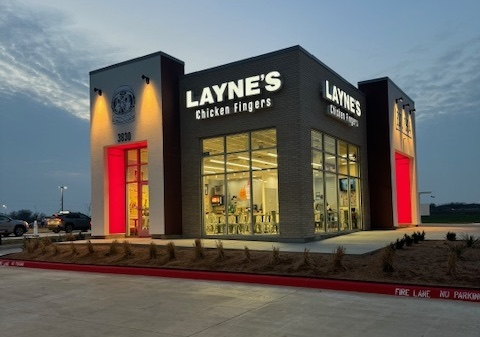3 Chains in Expansion Mode: Burgers, Chicken and Pickle(ball)
Shake Shack Plans To Multiply Its Company-Operated Locations by 5 Times

Shake Shack opened at Simon’s St. Johns Town Center in Jacksonville, Florida in September. Photo courtesy of Shake Shack
When Shake Shack launched its IPO in 2015, the burger chain laid out long-term plans for 450 company-operated locations. On Jan. 13 at the ICR Conference, the chain updated that forecast in a big way: at least 1,500 company-operated restaurants over the long haul. CEO Rob Lynch said the company sees “an ample runway for growth ahead.”
As of Dec. 25, Shake Shack had 329 company-operated locations, after opening a record high 43 during the 2024 fiscal year. A jump to 1,500 restaurants would be a sizzling 356% increase in Shake Shack’s company-operated footprint. Shake Shack expects to open 45 company-operated restaurants during its 2025 fiscal year, along with 35 to 40 licensed restaurants. In all, the chain comprises more than 550 restaurants, including over 350 in the U.S.
Layne’s Chicken Fingers Targets Hundreds of Restaurants

Photo courtesy of Layne’s Chicken Fingers
Layne’s Chicken Fingers executives hope to turn the brand into a household name, and the chain has hatched a plan for explosive growth. It foresees crossing the 100-restaurant mark in 2026 or 2027, according to a spokesperson, up from 18 at the end of 2024. Relying primarily on franchisees to propel growth, Layne’s is targeting expansion in its home state of Texas, along with the Midwest, Mid-Atlantic and Southeast. Thus far, Layne’s, which was founded in 1994, has sold 226 locations to franchisees, the spokesperson said. Its locations range from 1,500 to 3,000 square feet. The company reported a 9% year-over-year rise in same-store sales in 2024.
Pickleball Social Club Startup Plots Growth in Southern California

Image courtesy of Courtesy of California Smash
A start-up is courting pickleball locations measuring 30,000 to 40,000 square feet in Southern California’s Orange, San Diego and Ventura counties. California Smash pickleball and social club signed a lease over the summer for a 25,300-square-foot venue in Los Angeles’ El Segundo for its first location and plans to open in the spring with nine pickleball courts, DJs, a dance floor and a full-service bar and restaurant. Founder Brett Drogmund said his company is negotiating leases for two more facilities in Southern California and is eyeing additional locations “as we work toward our goal of owning the California market.” Although California Smash concentrates on indoor facilities, some locations will incorporate outdoor courts “to enhance the player experience,” he said.
MORE FROM C+CT: Landlords Craving Pickleball Can Learn from This Operator
Sephora Will Redesign Every Store in North America

Photo credit: Eduardo Barraza - stock.adobe.com
Sephora North America president and CEO Artemis Patrick said during the National Retail Federation Big Show this week that it will redesign every one of its stores in North America, as reported by Retail Dive. The chain already has worked on 111 of its more than 700 stores on the continent, and the bulk of the rest of the work — major in some stores, minor in others — will occur over the next five years, according to Retail Dive.
Joann Seeks a Buyer After Filing for Bankruptcy Again

Photo credit: Brett - stock.adobe.com
Joann plans to sell the bulk of its assets following its second bankruptcy filing in less than a year. The fabric and crafts chain said Wednesday that Gordon Brothers Retail Partners will act as a “stalking horse” bidder for the assets while the chain entertains other buyout offers. A bankruptcy judge would need to approve an asset sale. Joann said its more than 800 stores will remain open through the process.
The Chapter 11 bankruptcy case Joann filed this week comes after one it filed last March. Interim CEO Michael Prendergast said that Joann, since emerging from bankruptcy reorganization and becoming a private company last April, has focused on managing expenses and boosting the chain’s value. “However, the last several years have presented significant and lasting challenges in the retail environment, which, coupled with our current financial position and constrained inventory levels, forced us to take this step,” said Prendergast.
CBRE and Yardi Scoop Up Co-Working Companies

Industrious’ Bryant Park location. Photo courtesy of Industrious
Two real estate players are making big moves in the co-working sector. CBRE has agreed to acquire Industrious, and a day after CBRE’s announcement, real estate software provider Yardi said it had purchased two co-working platforms: Deskpass in the U.S. and Hubble in the U.K.
Since 2020, CBRE has amassed a roughly 40% equity stake in Industrious and has contributed a $100 million convertible note. CBRE will purchase the remaining equity for about $400 million. It expects the deal, which values Industrious at $800 million, to close this month. Industrious operates more than 200 co-working spaces in over 65 cities.
Yardi’s acquisition of the Deskpass and Hubble co-working marketplaces complements its existing CoworkingCafe platform. All three enable people to book desks, offices and meeting rooms at co-working spaces. Yardi global solutions president Rob Teel said the trio creates “a global infrastructure to connect office users with space from the best office owners and co-working operators.”
Retailers Help Victims of California Wildfires
Several retailers are helping residents of the Los Angeles area impacted by this month’s deadly wildfires, which NBC News reports have killed 27 people and destroyed 12,300 structures.
Here’ are some of the retailers that are supporting wildfire relief efforts in Southern California:
• Walmart, Sam’s Club and the Walmart Foundation have earmarked $2.5 million for relief efforts, including donations of food, water, essential products and grants. In addition, the Baldwin Park Walmart is hosting a mobile kitchen.
• Target is donating $1 million to relief efforts, according to a WWD roundup of retailers helping the Los Angeles community. Target also is rushing supplies to affected areas and providing direct financial aid to firefighters, first responders and affected communities.
• Grocery store operator Kroger has promised to raise $1 million for families affected by the wildfires. Kroger’s Southern California brands are Ralphs and Food4Less.
• Various Santa Monica Place retailers have launched relief efforts. Uniqlo, for example, will enable customers at its Santa Monica Place store to add $1, $3 or $5 to their purchases through Jan. 31. Ninety percent of those charitable donations will go to the Los Angeles Regional Food Bank, and 10% will go to Feeding America.
How U.S. Retail and Food Services Sales Fared in December
U.S. retail and food services sales minus motor vehicles, auto parts and gas rose 3.3% year over year in December, according to advance, seasonally adjusted data from the U.S. Census Bureau. That’s down from 4.1% in November and the slowest growth since August. Nonetheless, consumer spending remains robust, according to ICSC research manager Matthew Panfel. “Even though [2024] started with some uncertainty about consumer spending, concerns about a significant pullback were largely bucked, due in part to a resilient labor market and solid wage growth,” he said. “Consumers continued to make purchases last year, even if they were a bit more cautious.”
December Year-Over-Year Growth in U.S. Sales
Seasonally adjusted, advance data
| Furniture and home furnishings stores | 8.4% |
| Nonstore | 6% |
| Electronics and appliance stores | 5.8% |
| Miscellaneous store retailers | 3.7% |
| Health and personal care stores | 3.4% |
| Food-and-beverage stores | 3.1% |
| General merchandise stores | 2.6% |
| Clothing and clothing accessories stores | 2.4% |
| Food services and drinking places | 2.4% |
| Sporting goods, hobby, musical instrument and book stores | 1.8% |
| Building materials and garden equipment and supplies dealers | -1.8% |
By John Egan
Contributor, Commerce + Communities Today